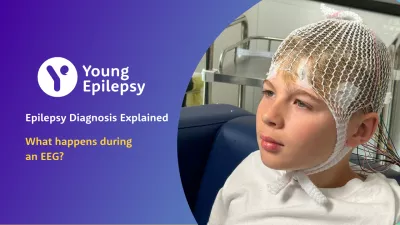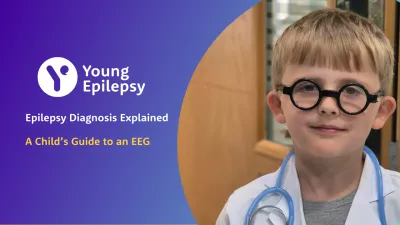This information is for people who want to know more about a type of test called an electroencephalogram (EEG). If your doctor thinks you have epilepsy, one of the main tests they will offer is an EEG.
On this page we answer some frequently asked questions (FAQs) about EEGs including what happens during an EEG, how you’ll be referred for one, and what the different types of EEG tests are.
Use this page as a general guide and speak to a health professional for more information and support.


Frequently asked questions (FAQs) about EEGs
An electroencephalogram (EEG) is a test that records electrical activity in the brain.
An EEG is painless and usually takes place in a hospital or clinic.
EEG testing alone cannot confirm or rule out a diagnosis of epilepsy, but it can help doctors to see electrical activity in the brain.
A routine EEG usually takes about 30 minutes. Other types of EEG recording may take longer, it could take several days in some cases.
Electrodes (small sensors), about the size of shirt buttons, placed on the head send signals to a computer, which records them.
The EEG only gives information about electrical activity in the brain during the recording.
An EEG alone does not confirm a diagnosis of epilepsy. This is because many people with epilepsy will have a normal result.
An EEG alone cannot rule out a diagnosis of epilepsy. But if the results do show where abnormal electrical activity is starting in the brain, it can help doctors find certain patterns. They may want to do more tests to help them know for sure if you have epilepsy.
This can then help them to identify the seizure type or specific epilepsy syndrome and decide on the right treatment for you. An epilepsy syndrome is a group of signs and symptoms that usually happen together, including particular types of seizures.
EEGs are most useful when they are used alongside video recordings (video telemetry) so the doctor can see what’s going on in your brain while watching how you’re behaving.
Types of EEG
These are the different types of EEG testing:
- Routine (awake) EEG
- Sleep EEG
- Ambulatory EEG
- Home video EEG telemetry
We describe each of them in more detail below.
Routine (awake) EEG
Watch a this video from Monty or our Specialist Nurse Consultant to find out what it’s like to have an EEG.
A routine EEG can be useful for anyone with a diagnosis, or suspected diagnosis, of epilepsy.
How should I prepare for an EEG?
There are a few things you can do to help you prepare for an EEG. These include:
- Making sure your hair is clean with no hair products, such as gel or hairspray. If your hair is long, leave it down or in a loose ponytail – the length or type of hair does not matter. You do not need to cut your hair.
- Bringing your favourite book, tablet, game or toy. For sleep EEGs you can arrive in your pyjamas and bring a comforter or blanket.
What happens during an EEG?
Your epilepsy specialist will explain what will happen during an EEG, so you feel prepared and know what to expect on the day. All hospitals will do things slightly differently, but usually during an EEG the following things will happen:
- The neurophysiologist (an expert in investigating how the brain works) will measure your head and mark your head with a soft crayon.
- They will attach 21 to 25 electrodes (small sensors about the size of shirt buttons) with paste or sticky tape. It normally takes about 15 to 25 minutes to attach the electrodes.
- You will be asked to sit in a chair or lie on a bed.
- You may be asked to open and close your eyes.
- You will be asked to do some exercises which are sometimes called activation exercises to help get the test started. These may include:
- Over-breathing – you will be asked to breathe faster and more deeply than normal for about 3 minutes – sometimes with a toy windmill
- Photic-stimulation – you will be asked to look at a flashing light.
Your parent or carer can stay with you. In some cases, usually for children with additional needs, you may be able to have more than one adult with you.
What happens after the EEG is done?
After the EEG is finished, the following things may happen:
- the neurophysiologist will take off the electrodes and sticky tape and wipe away the paste
- you will be told to wash your hair at home with normal shampoo.
Ask the neurophysiologist or the epilepsy specialist if you have any questions after your EEG is finished.
When will I get the results?
You might not get the results on the day. You will get your results from the doctor who referred you for the EEG test.
Sleep EEG
If a routine EEG doesn’t give enough information, you will normally need to do a sleep EEG.
A sleep EEG is done while you're asleep during the day. Sometimes it can be hard to sleep or settle, so your epilepsy specialist might offer you the hormone melatonin to help you sleep. Melatonin is usually available in capsules and can be dissolved in water, milk or juice or as a liquid in some hospitals. The dose will vary depending on the child’s age.
Sleep EEGs are very helpful for spotting seizures that happen when you’re sleeping.
Sometimes, you might be asked to sleep less the night before the test to help you sleep while the EEG is being done. This is called a sleep-deprived EEG.
How is a sleep EEG done?
A sleep EEG will go through the same steps as a routine EEG. But you will also need to do the following:
- Go to bed 1 to 2 hours later than normal and wake up 1 to 2 hours earlier than your normal bedtime the night before the sleep EEG.
- Stay awake on your way to the hospital or clinic and when you are in the waiting room.
- Go to sleep in a quiet dark room with your parent or carer.
- Have the EEG record you sleeping for about 30 minutes and then you will be woken up.
- In total it will last between 1 and 1/2 and 2 hours.
Ambulatory EEG
An ambulatory EEG means that you’re able to walk around during the test.
In an ambulatory EEG, the electrodes placed on your head are connected to a small recorder (the size of a packet of crisps) that sit in a bag around your waist.
An ambulatory EEG test is designed to record the activity in your brain over one or more days.
You don’t usually stay in the hospital while the test is being done. You can carry the small bag with you, so you are able to go about your day as normal. You might go home. You may also go to school while the EEG is recording your brain activity.
Your doctor will ask your parent or carer to keep a diary of your activities, such as sleeping and eating, while you are wearing the ambulatory EEG.
It usually lasts 24 to 48 hours, but sometimes it can last for up to a week.
At the end of ambulatory EEG, the information is transferred onto a computer back at the hospital. The epilepsy specialists involved in your care will then look at your results to help them work out if you have epilepsy.
Home video EEG telemetry (EEG with video recorded in the home)
Home video telemetry can be done at home in a similar way to an ambulatory EEG. You will be shown how to set up the equipment. Usually, the only difference is that it includes a video recorder so your specialist can see you on video alongside your brain activity.
Referral for an electroencephalogram (EEG)
If you have had your first seizure, and your medical history and assessment suggests it could have been an epileptic seizure, you might be referred for a routine EEG.
Based on national guidelines, the routine EEG should be done within 3 days after your first seizure. But most of the time doctors won’t ask for an EEG until after a second seizure. And it is likely that you will have to wait for weeks or months for the EEG.
If the results of the routine EEG are normal, then you might be asked to do a sleep-deprived EEG. A sleep-deprived EEG is an EEG that is done after a period of no or little sleep. When you are tired, there is more chance that there will be unusual electrical activity in your brain that can be picked up.
If the results of the sleep-deprived EEG are also normal, then you might be asked to do an ambulatory EEG for up to 2 days. With an ambulatory EEG, you can walk around.
If you are advised to have another type of EEG after the routine EEG, waiting times may vary from weeks to several months depending on where you are in the country.


